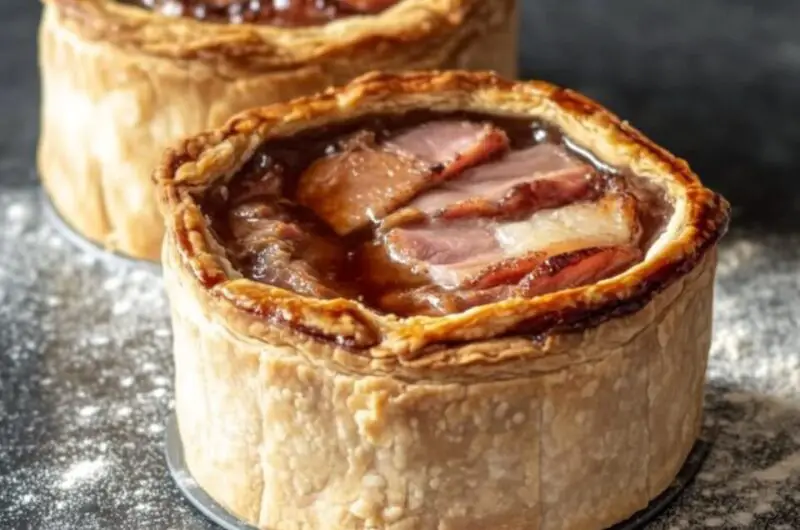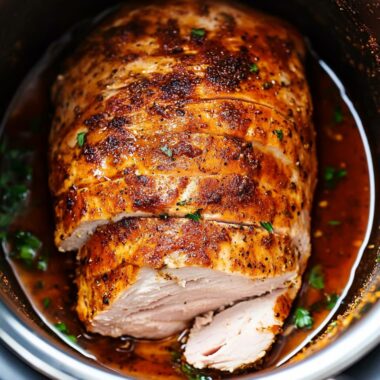A traditional British pork pie is the kind of recipe that feels like a warm hug from the past. Hand-raised with care, each pie tells a story of classic English baking, blending flaky hot water crust pastry with seasoned pork and a delicate savory jelly for the perfect slice. This hearty pie makes a standout centerpiece for any picnic, lunch spread, or cozy indoor gathering. It’s not only satisfying but beautifully rustic perfect when served with pickles, chutneys, or mustard on the side. Try this timeless dish and taste the rich history in every bite.
Full Recipe:
Ingredients:
-
500g pork shoulder, finely chopped
-
200g pork belly, finely chopped
-
100g streaky bacon, chopped
-
1 tsp salt
-
½ tsp ground white pepper
-
½ tsp ground nutmeg
-
¼ tsp ground mace
-
2 tsp fresh thyme leaves
-
1 tsp English mustard
-
1 small onion, finely chopped
For the hot water crust pastry:
-
200g lard
-
220ml water
-
600g plain flour
-
1 tsp salt
For the jelly:
-
2 pork stock cubes
-
300ml boiling water
-
4 gelatine leaves
Directions:
-
Preheat the oven to 180°C (350°F).
-
In a large bowl, mix the chopped pork shoulder, belly, and bacon with salt, pepper, nutmeg, mace, thyme, mustard, and onion. Set aside.
-
In a saucepan, gently heat the lard and water until the lard has melted. Remove from the heat.
-
Place the flour and salt in a bowl, then pour the hot lard mixture into it. Stir until a dough forms.
-
While still warm, shape the dough by hand or using a mould into the base and sides of a tall pie tin or traditional pork pie dolly. Reserve pastry for the lid.
-
Pack the meat mixture firmly into the pastry case.
-
Roll out a lid from the remaining pastry and seal the pie, creating a small hole in the center to allow steam to escape.
-
Bake in the oven for 30 minutes, then reduce temperature to 160°C (320°F) and bake for another 1 hour.
-
Once cooled slightly, mix the gelatine in the hot stock and pour through the steam hole. Allow to set overnight in the fridge.
Prep Time: 40 minutes | Cooking Time: 90 minutes | Total Time: 2 hours 10 minutes
Kcal: 520 kcal | Servings: 8 servings
The Traditional British Pork Pie: A Rich Culinary Heritage
Few dishes capture the essence of traditional British cookery quite like the pork pie. With its golden, hand-raised hot water crust and seasoned pork filling set in a savory jelly, this pie is not just a meal it’s a celebration of British food heritage. Whether gracing a festive spread, accompanying a picnic in the countryside, or featured as a rustic delicacy at the local pub, the pork pie has remained a beloved staple in British cuisine for centuries.
A Glimpse Into History
The origins of the pork pie date back to the Middle Ages, when pies were primarily a means of preserving meat. Early versions weren’t necessarily eaten for their pastry; rather, the crust referred to as a “coffin” was thick, inedible, and used more like a container. Over time, as pastry-making techniques evolved and became more refined, the crust transformed into the crisp, golden shell we now associate with modern pork pies.
By the 18th and 19th centuries, the pork pie had become a fixture in English towns, particularly in Melton Mowbray, a market town in Leicestershire. It was here that the pie as we know it today cold, jelly-filled, and enrobed in hot water crust pastry was perfected. Melton Mowbray pork pies even received Protected Geographical Indication (PGI) status from the EU, much like Champagne or Parmigiano-Reggiano, emphasizing their cultural and regional importance.
The Iconic Hot Water Crust Pastry
One of the hallmarks of a traditional pork pie is its hot water crust pastry. This unique pastry is markedly different from the shortcrusts or puff pastries used in other British pies. Made by boiling lard and water together before incorporating it into flour, hot water crust is rich, pliable, and perfect for molding by hand or over a pie dolly.
Its main advantage lies in its structural integrity. Once shaped and baked, this crust can support a dense filling without becoming soggy or collapsing. The crust’s robustness also lends it an aesthetic appeal, creating pies that look as rustic and hearty as they taste.
The Pork Filling: More Than Just Meat
Inside the golden crust lies the soul of the pie: a carefully seasoned pork mixture. Traditional recipes call for a combination of pork shoulder, pork belly, and streaky bacon. These cuts are not only flavorful but offer the right balance of fat and lean meat, ensuring that the filling remains moist and tender after baking.
Seasonings typically include salt, white pepper, mace, nutmeg, thyme, and sometimes mustard ingredients that subtly enhance the pork without overpowering it. Many home cooks and butchers have their own secret spice blends, passed down through generations, giving each pork pie its unique character.
The Role of the Savory Jelly
A defining feature of the pork pie is the jelly. After baking, the pie is allowed to cool slightly before a rich pork stock mixed with gelatin is poured through a hole in the top. As the pie chills, the jelly sets, filling the gaps between the meat and pastry. This jelly not only enhances the pie’s flavor and moisture but also acts as a preservative.
Historically, the jelly was made from boiling pig’s trotters or bones to extract natural gelatin, though modern versions often use ready-made gelatin for convenience. While some may find the idea of jelly in a meat pie curious, it is one of the elements that distinguishes a true British pork pie from lesser imitations.
Pork Pie in British Culture
Beyond its culinary significance, the pork pie holds a unique place in British culture. It symbolizes tradition, celebration, and craftsmanship. Often associated with picnics, Boxing Day feasts, and pub lunches, pork pies are versatile and enjoyed year-round.
In some regions, pork pies are served with a dollop of English mustard or a tangy pickle. In Yorkshire, they may be eaten with mushy peas and mint sauce. These regional nuances speak to the pork pie’s adaptability and the creativity of British cooks over the centuries.
There’s also a touch of humor and language tied to the pie. In Cockney rhyming slang, “pork pie” translates to “lie,” as in “Don’t tell me porkies!” a testament to how deeply embedded the pie is in British vernacular.
Regional Variations
While Melton Mowbray is the most famous variant, other regions across the UK have put their spin on the pork pie. For example:
-
Gala Pie: A long version of the pork pie with a boiled egg encased in the center. Sliced into beautiful cross-sections, it’s often served at weddings and formal gatherings.
-
Yorkshire Pork Pie: Typically served hot and with gravy, diverging from the traditional cold service style.
-
Mini Pork Pies: Found in supermarkets and bakeries, these are snack-sized versions perfect for lunchboxes or party platters.
Each variation maintains the essence of the pork pie while offering unique textures, flavors, and presentations.
Tips for the Best Pork Pie Experience
Enjoying a pork pie isn’t just about eating it’s about savoring the layers of texture and taste. Here are some tips to elevate your experience:
-
Serve Cold or Room Temperature: Traditional pork pies are typically served cold. Allowing the pie to come to room temperature helps the jelly soften slightly and enhances the flavor.
-
Pair with Pickles: Accompaniments like Branston pickle, piccalilli, or apple chutney add a delightful tang that contrasts beautifully with the rich pork.
-
Cut with Care: Use a serrated knife to slice the pie cleanly without crumbling the crust or displacing the jelly.
-
Pair with Ale or Cider: A pork pie is never out of place at a British pub, and a pint of cask ale or dry cider pairs wonderfully with its richness.
Pork Pie in Modern Cuisine
While the pork pie is rooted in tradition, contemporary chefs are embracing it in new and creative ways. Some incorporate game meat like venison or rabbit, while others experiment with flavor infusions such as caramelized onions, spiced chutneys, or applewood-smoked bacon.
There are even vegetarian and vegan interpretations using lentils, mushrooms, and plant-based pastry alternatives proof that the pork pie’s structure and concept are so iconic that they transcend dietary boundaries.
Advertisement
For many, baking a pork pie is not just a recipe but a rite of passage. It demands patience, skill, and respect for tradition yet rewards generously in flavor and satisfaction.
Conclusion:
The traditional British pork pie is more than a dish it’s a culinary institution. From its humble medieval origins to its revered status in modern British food culture, the pork pie represents craftsmanship, heritage, and the comforting joy of honest, hearty food.
Whether made by hand at home or purchased from a local butcher steeped in generational knowledge, a well-made pork pie is a true labor of love. It encapsulates what British cooking does best: transforming simple ingredients into something timeless, flavorful, and steeped in tradition.
For those who have never tried a proper pork pie, it’s time to discover what you’ve been missing. And for those already enamored, why not try your hand at making one from scratch? Once you’ve had the real thing golden crust, rich pork, savory jelly there’s no going back.








